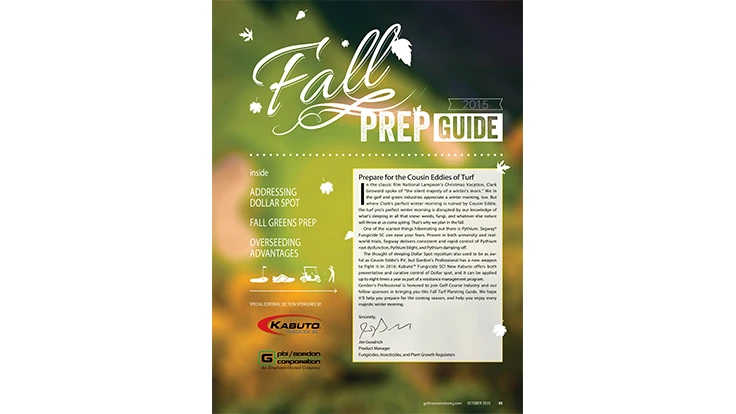
.jpg) In much of North America the golf season is winding down and turf professionals are planning for seasons yet to come. In other locales, the season is shifting into high gear and superintendents are preparing their turf for heavy traffic.
In much of North America the golf season is winding down and turf professionals are planning for seasons yet to come. In other locales, the season is shifting into high gear and superintendents are preparing their turf for heavy traffic.
Preventative work does a lot to ward off potential problems. Dr. Karl Danneberger, an associate professor at The Ohio State University, stresses the importance of adding the right combination of nutrients to the soil at this time of year, particularly in regions where cool-season grasses prevail.
“As you go into the fall, your soil fertility levels need to be adequate,” says the turf prof. “Phosphorous, potassium and nitrogen are the major elements. If you’re deficient on those or on the low end of that going into winter, that plant is just not going to be as healthy.”
Don’t underestimate the value of aerification, says Jim Goodrich, product manager for fungicides, insecticides and PGRs for PBI-Gordon, and a former superintendent.
“Some guys like to pull cores in the spring and then just punch holes if you will in the fall,” he says, “and not affect that much material as far as pulling it out of the ground. A lot of guys, and I was one of those guys, we pulled cores in the spring and also in the fall to get ready for next spring.
“A lot of guys are of that school of thought, if you can remove a lot of material at the beginning of the season after you’ve overwintered and maybe you’ve had some compaction issues, then maybe you come back at the end of the season when you’ve had fertilization all year and maybe built your thatch layer up,” he says. “You don’t necessarily want that thatch layer. A lot of bad things happen when you have too much thatch. It’s a disease layer and it also leads to shallow rooting, as well.”
Adding a layer
Superintendents’ concerns for turf health intensify with the approach of winter. Chief among those is protecting their greens. In northern locales, where many golf facilities close for the winter, some superintendents cover their greens with sand or straw. But others will use plastic or some similar material to provide, literally, an additional layer of protection against snow or ice damage.
Jeff Johnson, the superintendent at the Minikahda Club in Minneapolis, covers his greens with a product developed by GreenJacket in Genoa City, Wis. Essentially, it’s a sheet of plastic (the company refers to it as an ice shield) cut to fit each green. Johnson also utilizes WatchDog data loggers to track what was going on under the plastic.
“If we had an anomaly and turf died, I could maybe look back at those records,” Johnson says. “If we had a January or February thaw and the air temperature reached 50 or 60 degrees… What happened under that cover, there was no way of knowing.”
About a decade ago, GreenJacket introduced an additional component; a layer of foam one-eighth-of-an-inch thick to provide an additional layer of protection, an approach favored by some Canadian superintendents, for obvious reasons. The full GreenJacket system includes not only the covers and foam, but also a series of sensors at each green site that measure soil temperature and CO2 levels. The system also includes ventilation tubes that allow fresh air to circulate over the greens if CO2 levels get too high, which happens about once a week in some parts of Canada.
Today, Johnson protects 19 of his 21 greens with a cover. Two of his practice greens are comprised of bentgrass and aren’t covered.
There are a number of artificial covers on the market, as well. Each has its own advantages and disadvantages and the turf conditions at a particular facility may dictate what is appropriate or practical.
Superintendents often will adjust their winter preparations in light of practical (i.e. fiscal) concerns.
Eric Nelson is the superintendent at the 1757 Golf Club, a daily-fee facility in Sterling, Va., just outside of Washington, D.C. He does his fall aeration in mid-August. Ideally, he’d wait until Sept. 15 when nighttime soil temperatures drop into the 50s, but that’s not feasible because of the amount of fall play at the club.
This scenario is far from unique. While some clubs in northern latitudes will shut down for the winter months, many more do not, leaving superintendents to find the right balance between protecting their turf and satisfying members’ wishes.
“I would love to be able to bury my greens in sand every year on December first,” Nelson says, “That’s not feasible, but I still have to protect against snow mold. So you have to do a preventative fungicide application in late November.”
Whether a facility closes for the winter or remains open, there are ways to protect the turf and minimize potential problems.
For example, many superintendents cut their greens a bit higher than normal during hot weather to reduce heat stress. Danneberger says a new school of thought is this strategy can be effective in preparing for the winter, as well.
“Generally the height of cut has not really been a factor in winter injury,” he says. “But a couple years ago there was some correlation, although nothing has been published on it. From my experiences and some other people’s experiences, if you’re one of those people who maintained an extremely low height of cut, you’re going into winter bring that height up slightly. Normally, you wouldn’t think that but these guys are mowing so low it potentially can be an issue.”
In preparing for a winter shutdown, Danneberger suggests applying a topdressing might be in order. “It’s an old practice,” he says, “but late in the fall, when play is almost non-existent, do a heavy topdressing to provide some protection for the crown.”
If the facility is going to remain open during the winter, utilizing temporary greens may be a prudent step. There is also the option of alternating between two cups on each green.
“They have these awesome new plugs now,” Goodrich says. “You’ll have two cups. You can put one in play for the day and then switch the flags.”
Danneberger notes heavy traffic on greens during fall and winter can impact what happens in the spring. “Poa annua germinates in the fall,” he says. “When you have winter play, that can be a real problem. You have golfers playing on those greens and they’re not growing while the Poa is germinating. Greens get a little more compacted and that can enhance Poa establishment, which you’ll see in the spring.”
Superintendents in warmer climates face different challenges. Jeff Marvin, PBI-Gordon’s manager of field research, says courses in warmer climates will see a lot of play in a concentrated timeframe, the bulk of it coming between Thanksgiving weekend and the end of April. This pattern of play impacts fall prep work.
As a former superintendent, Marvin would apply extra nutrients to the soil, the customary blend of nitrogen, potassium and phosphorous, to strengthen the root system. He would also monitor his Bermudagrass greens to determine the best time to schedule his fall aeration.
“I would try to schedule my last aerification as close as I could to the Bermudagrass wanting to slow down,” Marvin says. “It’s kind of a fine line. I wanted to get an aerification in to keep the greens opened up, but you’ve got to allow enough time to heal up.” Marvin would schedule that aeration for late September or early October, which theoretically would have his greens ready ahead of the occasional cool that occurs in Florida in the fall.
In warm climates, it’s often necessary to aerate periodically throughout the winter, perhaps as often as once a month.
“You can’t core aerify because the plant is not going to heal up,” Marvin says. “You’re going to have half-inch holes in your greens. What you have to do is come in with what I call needle tines; it’s very small, maybe an eighth-of-an-inch in diameter. You needle-tine your greens to first, allow water infiltration if you do get some rain, and allow some gas exchange … If you’re not draining, then water is going to sit on the green and you start getting algae.”
Get curated news on YOUR industry.
Enter your email to receive our newsletters.
Explore the October 2015 Issue
Check out more from this issue and find your next story to read.
Latest from Golf Course Industry
- Carolinas GCSA raises nearly $300,000 for research
- Advanced Turf Solutions’ Scott Lund expands role
- South Carolina’s Tidewater Golf Club completes renovation project
- SePRO to host webinar on plant growth regulators
- Turfco introduces riding applicator
- From the publisher’s pen: The golf guilt trip
- Bob Farren lands Carolinas GCSA highest honor
- Architect Brian Curley breaks ground on new First Tee venue





